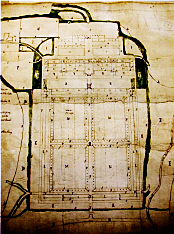
Layout of the garden
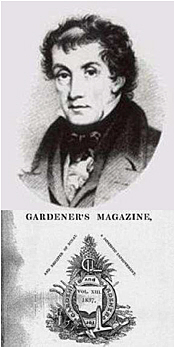
Scots-born
garden and landscape writer John Loudon fitted an extensive range of
glasshouses in the Old Garden in the early 1800's in an attempt to
overcome the problems with frost and cold weather
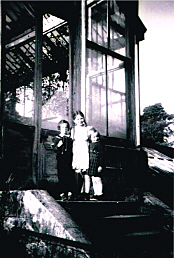
Youngsters outside the conservatory in it's glory.

Duke of Windsor visits the peach house at Penicuik
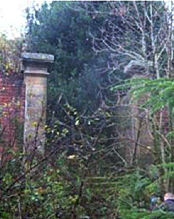
The overgrown grand staircase leading to the conservatory green house.
|
| | | Penicuik Lost Garden - 20th October |
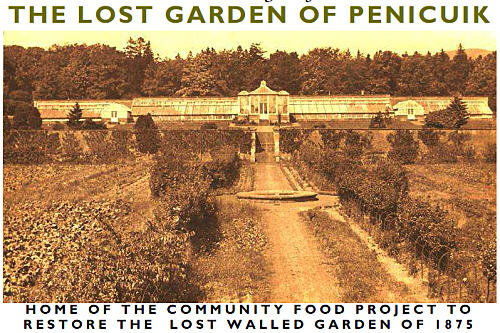
Roger
Kelly from the Penicuik Development Trust presented a history of the
Penicuik Lost Garden to the Guild meeting on Monday 20th October.
Roger, with the aid of slides, provided an interesting and
entertaining view of the origins and life of the Penicuik Lost Garden,
explaining how it became 'lost'.
 Many
people do not know where the 'lost' garden actually is and often think
that it is the semicircular walled garden at Eskfield, south-west of
Penicuik House, at the bottom of the hill beside the river Esk. This is
in fact the 'Old Garden' designed by Sir James Clerk the 3rd Baronet of
Penicuik in the 1760's. Originally designed to provide fresh
vegetables, fruit and flowers, Roger explained that the location
suffered from frost and cold winds blowing up the Esk valley, resulting
in poor yields from the garden. However, this riverside garden at
Eskfield continued to provide the estate’s needs for the next
hundred years and more This Old Garden remains visible in the
Penicuik House Estate landscape unlike its 1875 successor the Lost
Garden which has become hidden from public view. Many
people do not know where the 'lost' garden actually is and often think
that it is the semicircular walled garden at Eskfield, south-west of
Penicuik House, at the bottom of the hill beside the river Esk. This is
in fact the 'Old Garden' designed by Sir James Clerk the 3rd Baronet of
Penicuik in the 1760's. Originally designed to provide fresh
vegetables, fruit and flowers, Roger explained that the location
suffered from frost and cold winds blowing up the Esk valley, resulting
in poor yields from the garden. However, this riverside garden at
Eskfield continued to provide the estate’s needs for the next
hundred years and more This Old Garden remains visible in the
Penicuik House Estate landscape unlike its 1875 successor the Lost
Garden which has become hidden from public view.
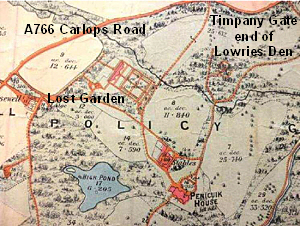 The
New Garden had been built around 1877. The design was geared to
horticultural production on a very big scale: vegetables, flowers and
fruit. Plans for the stairway to connect the two main levels were drawn
up by John Leslie in 1875. With its imposing entrance gates, grand
staircase and hot-houses ranged along the skyline the New Garden would
be an astonishing ornament to a newly diverted drive across a new
bridge from Tympany Lodge. Then, after a hundred years of productive
life, it would begin to disappear like a mirage. The
New Garden had been built around 1877. The design was geared to
horticultural production on a very big scale: vegetables, flowers and
fruit. Plans for the stairway to connect the two main levels were drawn
up by John Leslie in 1875. With its imposing entrance gates, grand
staircase and hot-houses ranged along the skyline the New Garden would
be an astonishing ornament to a newly diverted drive across a new
bridge from Tympany Lodge. Then, after a hundred years of productive
life, it would begin to disappear like a mirage.
Roger explained
who was involved in the building of the garden, the conservatory, and
the surrounding walls and outhouses. He went on to talk about some of
the famous people to visit the garden, including Prime Minister William
Gladstone, MP for Penicuik, who visited the forestry Exhibition in
1885, and the Prince of Wales, the Duke of Windsor in 1924, to sample
the peaches grown in the greenhouse.
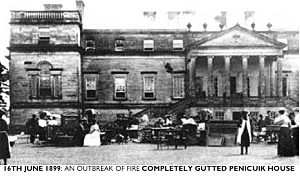 After
the great fire of 1899 when the main house was significantly damaged,
and the family moved into the stable block the 'lost garden' was
leased out to the first in a series of market gardeners. After
the great fire of 1899 when the main house was significantly damaged,
and the family moved into the stable block the 'lost garden' was
leased out to the first in a series of market gardeners.
By the
1960's the garden started its journey into decline. The building of
Cornbank brought supermarkets, sourcing cheaper fruit and vegetables
brought in from abroad. By the seventies the garden was desolate, so a
venture to plant Christmas trees and manufacture charcoal for the now
much larger population of Penicuik was started, but soon fell away
leaving the ground overgrown with pine trees and unused charcoal buried
in the ground.
 The
Penicuik Community Trust became involved around 2005 to start a project
to restore the Lost Garden back to its former glory. Working with
the Clerk family, they have cleared the area, started planting
vegetables in the gardens, and begun the long restoration work to the
conservatory (green house). You can read all about the history and
current activity at the Lost Garden of Penicuik website The
Penicuik Community Trust became involved around 2005 to start a project
to restore the Lost Garden back to its former glory. Working with
the Clerk family, they have cleared the area, started planting
vegetables in the gardens, and begun the long restoration work to the
conservatory (green house). You can read all about the history and
current activity at the Lost Garden of Penicuik website
A vote of thanks was given to Roger following his very revealing talk.
| |